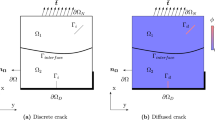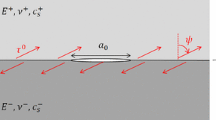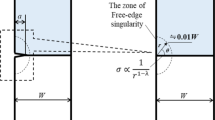Abstract
Finite element computation are carried out to simulate plane strain crack growth on a bimaterial interface under the assumption of small scale yielding. The modified Gurson constitutive equation and the element vanish technique introduced by Tvergaard et al. are used to model the final formation of an open crack. It is found from the calculation that the critical fracture toughness for crack growth is much lower in bimaterials than that in homogeneous material. The critical fracture toughness is strongly dependent on material properties of the bimaterial pair and the mixed mode of remote loads. The interface crack grows in the more compliant (lower hardening) material or in the weaker (lower yield strength) material. In Mode-I loading, the crack grows zigzag along the interface.
Similar content being viewed by others
References
Williams ML. Bulletin of the Seismological Society of American, 1959, 49: 199–204
Erdogan F. J Appl Mech, 1963, 30: 232–236
Sih GC, Rice JR. J Appl Mech, 1964, 31: 477–482
England AH. J Appl Mech, 1965, 32: 400–402
Erdogan F. J Appl Mech, 1965, 32: 403–410
Rice JR, Sih GC. J Appl Mech, 1965, 32: 418–423
Rice JR. J Appl Mech, 1988, 55: 98–103
Shih CF, Asaro RJ. J Appl Mech, 1988, 55: 299–316
Shih CF, Asaro RJ. J Appl Mech, 1989, 56: 763–779
Shih CF, Asaro RJ. Mat Sci Engng, 1989, A107: 145–157
Zywicz E, Parks DM, J Appl Mech, 1989, 56: 577–584
Wang TC. Engng Fract Mech, 1990, 37: 527–538
Needleman A. J Appl Mech, 1987, 54: 525–531
Varias AG, O'Dowd NP, Asaro RJ, Shih CF. In: Metal-Ceramic Interface, Acta-Scripta Metallurgica Procceeding Series, Santa Barbara, 1990, 4: 375–382.
Gurson AL. Plastic flow and fracture behavior of ductile metarials incorporating void nucleation, growth and interaction. Brown Univ, 1975
Gurson AL. J Engng Mat Tech, 1977, 99: 2–15
Tvergaard V. Int J Fract, 1981, 17: 389–407
Tvergaard V. Int J Solids Struct, 1982, 18: 659–672
Tvergaard V, Needleman A. Acta Metallurgica, 1984, 32: 157–169
Needleman A. In: Theoretical and applied mechanics, North-Holland: Elsevier Science, 1989, 217–240
Needleman A, Rice JR. In: Mechanics of sheet metal forming, New York: Plenum Publishing Co, 1978, 237–267
Shih CF, Asaro RJ. Int J Fract, 1990, 42: 101–116
Shih CF, Asaro RJ, O'Dowd NP. J Appl Mech, 1991, 58: 450–463
Author information
Authors and Affiliations
Additional information
Project supported by Fok Ying-Tung Education Foundation and National Natural Science Foundation of China.
Rights and permissions
About this article
Cite this article
Xuefu, L., Aoki, S. Elastic-plastic crack growth on plane strain bimaterial interface. Acta Mech Sinica 8, 261–270 (1992). https://doi.org/10.1007/BF02489250
Received:
Issue Date:
DOI: https://doi.org/10.1007/BF02489250




